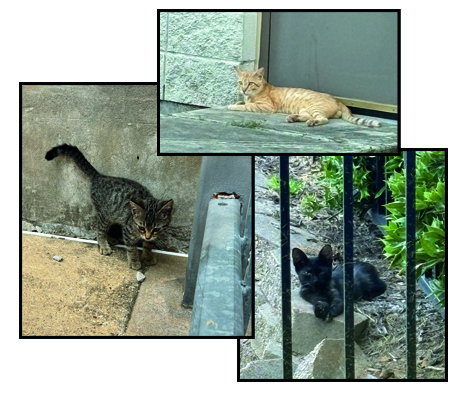
As students and teachers know, Bryan High School has a cat problem; at one point, 43 cats were accounted for on school grounds, but there are believed to be more. Cats roam underground in crawl spaces beneath the school during the day and emerge from hiding at night to terrorize the school further. Though these fuzzy, seemingly friendly felines appear to cause no issues, the school faces multiple problems regarding the overabundance of cats.
Now, before you hop on my tail about how I seem to hate cats, I am proposing a plan to decrease the mortality rate of cats and increase their quality of life. If you ask anyone who knows me, they will say that I am a huge cat lover, probably even the biggest cat lover in the entire universe.
Before being informed of the problems the cats cause, I always thought they were negligible to the school community. Sure, I saw cats roaming around during school and stopped to look in awe at the cute fuzzy creatures, but my thoughts on them did not really go beyond that.
Many may wonder why it is so bad to have cats roaming around campus, and I wondered the same thing until I saw why firsthand.
Since Bryan High is such a high-traffic zone, especially during arrival and dismissal times, I have seen at least four cats run over by cars in the past five months.
It is a heartbreaking sight to see.
Knowing that the cats were just roaming around doing whatever cats do, and their lives ended suddenly, is so sad. I have also seen students messing with the limp corpses of the cats after they have been run over, which on its own is horrible, but paired with the fact that they could have contracted whatever diseases that cat had makes it even worse.
As the cats wander around the school during the day, I have also seen students try to pet them, which is dangerous because students could contract fleas or rabies from an infected cat. Though many believe cats cannot carry the rabies virus, it is still possible.
Another misconception about rabies is that if an animal has rabies, they become rabid and aggressive; however, that is not always the case. There is a stage of rabies that makes the host seem timid and confused, which may make the animal appear shy, causing more people to attempt to approach it.
I am sure many students at Bryan High remember the kitten in the fine arts courtyard and how students tried to pet it. Some students caught the cat and passed it around to hold, which was somewhat disheartening. I could tell that the cat was in distress, and on top of that, the cat was a stray and had never been vaccinated or checked out by a vet. The cat could have had worms, fleas, or even rabies, and the students were just passing it around without regard for the cat’s or their safety.
Though many would assume feeding the cats would be a kindhearted act, there are still problems that could make the situation worse. I know someone feeds the cats around the school, but when I saw a giant mound of cat food piled by the flagpole, I questioned if it did more harm than good. One of the most positive things about having cats around is that they kill rats and other pests, so providing them with an abundance of food limits their need to hunt.
It has also recently been made illegal to feed stray animals in Texas, including stray cats. According to ordinance § 91.022, established on 7-13-21,
“It is unlawful for any person to feed wild animals, stray animals, or feral/community cats, regardless of age, sex, or temperament. It is also unlawful for any person to place food of any kind with the intent to feed wild animals, stray animals, or feral/community cats, along with storing or maintaining food of any kind in a manner or area accessible to wild animals, stray animals, or feral/community cats.”
Leaving the food out is also a crime, as it attracts even more cats to the school, creating a more significant problem.
The food also attracts raccoons and skunks, which are more likely to have diseases, including rabies. Raccoons and skunks have over a 20% chance of being infected with rabies, and the school does its best to prevent them from coming onto school grounds.
Just last year, a raccoon crawled above the ceiling tiles and fell through (probably because it was so fat from eating piles of cat food). It ran through the halls, and several people had to chase it to remove it from the building. I have also seen and smelled the many skunks roaming the school courtyard areas, and at times, they have even chased students. These wild animals cohabitate with cats, increasing the school’s problems and complicating maintaining a safe environment.
The cats have also destroyed the landscaping around the school. There used to be beautiful trees and bushes full of flowers in front of the flagpole and the courtyard. The cats used the dirt in these sheltered areas as their litter box, killing most of the foliage. The school then had to pay several thousand dollars to remove the dead plants because of the risks they posed to students.
In light of all the negative issues surrounding the stray and feral cats on campus, those taking the overpopulation into their own hands have also ruffled some feathers.
Through the Trap-Neuter-Return programs, also known as TNR, shelters have worked to decrease the population of cats at Bryan High by capturing them, vaccinating and neutering them, and then releasing them back on the premises so they do not continue to breed. Before the program began in the areas surrounding Bryan High, the cats were captured and attempted to be domesticated, but that was unsuccessful because they were too feral and, in turn, had to be put down.
Though TNR seems like a good idea, I do not see why the program must return the cats to Bryan High. If the goal is to save cats from being euthanized and give them another chance at life, they would put them somewhere they could thrive without posing a risk to people, especially kids.
The people participating in the TNR program have referenced the “vacuum theory” as a defense against removing the cats from Bryan High. In simple terms, this theory states that once cats are removed, more cats will come in to replace them. However, after some research, this theory does not seem all that sustainable.
Three Australian biologists conducted the study that established the vacuum theory in a forest on the island of Tasmania. The cats the scientists used for this experiment had no contact with humans, unlike the cats at BHS that interact with and are fed by humans.
The researchers killed some cats to create a “vacuum” to attract other cats. However, many other researchers have extrapolated these circumstances and non-reproducible findings to all outdoor cats in the US. The findings of this study are nothing like those of the stray and feral cat environment in the US, especially BHS. Yet, most shelters and activists reference this theory as the foundation of their TNR program. If the programs want to prove this theory is valid, they must find reproducible evidence in a similar environment to BHS.
Recently, a veterinarian from a local program came onto the school property and released five cages of feral cats. Principal Lane Buban saw the footage on the security cameras and was appalled by what he saw.
From Buban’s perspective, it appeared that some random person was releasing eleven cats onto the premises for no justifiable reason. The group’s TNR program had not contacted Bryan High about practicing on campus, so Buban was wildly confused about what was happening.
He called the authorities and filed a trespass warning on the woman, preventing her from coming to the school in the future. Though the program said they had permission from the church next door, they were still driving in the BHS parking lot and releasing the cats without contacting the school.
Members of the program became angry that Buban called the authorities because they believed they were trying to perform a good deed. Still, rather than communicating with the school, they decided to slander Bryan High on Facebook.
As I read their rant, it was clear that they did not attempt to see the situation from the other perspective. They made themselves seem like angels, which makes sense, and it would be somewhat alright if it stayed within their community. Still, users started tagging local media personality Rusty Surrett, and it has since been reshared 55+ times, prompting more people to be under-informed of what actually happened. The article makes no mention of their lack of communication with the school, which is kind of necessary when trying to get all the facts.
I also read some of the comments under the post; some were insane and saddened me because they showed me that people lack common sense and critical thinking skills. One user commented “What a great project for the high school students to volunteer with. The school is hurting all involved.”
I’ll give you approximately one minute to think about why what that person commented is bizarre.
Times up, I’ll go ahead and tell you.
How on earth is that person expecting BHS students to help? By catching the critters themselves and vaccinating them? Do you seriously trust the yahoos at this school to do any of those things correctly? The answer is no. Some people here do not even know how to flush a toilet after they are done in the bathroom, let alone catch and release animals. This would also obviously increase the chance of students contracting the diseases the cats may carry, which is precisely what we do not want.
Another commenter replied, “Bryan ISD, it is ridiculous that you fail to educate yourself on the situation… please teach this school district the importance of TNR.”
Though I agree that TNR is important in managing the cat population in some areas, it is still crucial to communicate clearly with who you are working with. If the program had reached out to BHS and told them about what they do, it would be a different story.
Ironically, this commenter said the district failed to educate itself about the situation. Yet, they probably did not ask for the other side of the story or try to educate themselves about how this problem impacts the school. Maybe, try to listen to your own advice if you write hate comments on something you are uneducated about.
When all is said and done, what TNR is doing as a program is moving in a positive direction, but they need to make sure clear communication with all parties involved is happening to ensure something like this does not happen again.
I think they should still capture and help the cats, but when it comes to Bryan High, they should release them elsewhere, preferably somewhere not around teenagers.
Relocating the cats means food would not need to be put out for animals, which would help solve the skunk and raccoon problem. This also means that the students would be at a lower risk of contracting illnesses the animals may carry. The school could also plant new greenery without fearing it getting trampled and used as a litter box. I hope the cat problem gets solved one way or another; something else needs to be done because, clearly, what is being done now is not working.
The upheaval of keyboard warriors complaining about Bryan High’s response to the illegal release of cats on campus and their calls for people to email the school board, the superintendent, and anyone else they can find on the district’s web page leads me to ask one more question: What would happen if people were this passionate about education?








Cindy Conte • Nov 23, 2024 at 8:58 am
Reily, I normally wouldn’t have spent the time reading this entire article — I would have scanned quickly. But your writing style was excellent, your topic was well researched, you helped the reader understand both sides of the story. Well done!
Elna Marsh • Nov 22, 2024 at 1:44 pm
I taught your mother at LHS and she was an excellent student as I know you are also. This article is written well, makes some excellent points, and ends with a thought provoking question. I might also add that many people are more concerned with what will happen to those cats than they would be about a homeless person. Sometimes human priorities are extremely confusing (or at least to me).
Sandy Farris • Nov 21, 2024 at 10:14 pm
Excellent article, Reily. You obviously understand the importance of thoroughly researching a story. Good job!
W. Kamphoefner • Nov 23, 2024 at 8:39 am
Young lady, you may have a future in journalism, if journalism manages to survive.